A.J.S. Rayl • Jun 15, 2018
The Mars Exploration Rovers Update Special Report: Opportunity Pummeled by Massive Dust Storm, Hunkers Down to Sleep
June 14, 2018
Entrenched in the west rim of Endeavour Crater, veteran robot field geologist Opportunity is hunkered down in Perseverance Valley in a kind of hibernation mode. The rover is sleeping to save what little power she has left in hopes of surviving a dust storm the likes of which the Mars Exploration Rover (MER) mission has never experienced, a dust storm so rare that every NASA asset at the Red Planet will be checking it out.
“I'm not sure what to say other than this is the worst storm Opportunity has ever seen, and we're doing what we can, crossing our fingers and hoping for the best,” MER Principal Investigator Steve Squyres, of Cornell University, told The MER Update.
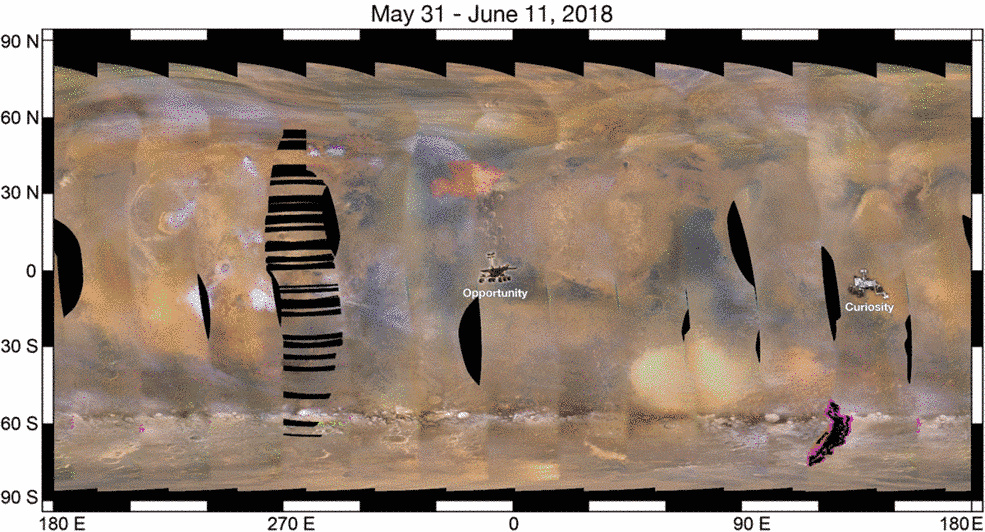
During the last two weeks, what began as a regional Martian dust storm expanded into an event, and then, when it moved over Endeavour Crater, it stalled. As it churned, the winds lofted a huge amount of dust into the atmosphere, blotting out the sky, turning day into night and leaving Opportunity blanketed in the powdery rusty-red stuff of Mars.
“The dust here is thicker than anything I have ever encountered, going back to Viking missions,” said MER Deputy Principal Investigator Ray Arvidson of Washington University St. Louis, who served as Science Team Leader for the imaging system on NASA's Viking Landers from 1977 to 1982. “It’s dark, like the end of twilight dark.”
The team responded as quickly as possible. But this storm moved fast, its expanse increasing by jaw-dropping numbers.“When we first heard about this thing, it covered 13 million square kilometers,” said Chief of MER Engineering Bill Nelson, of JPL, where all NASA’s Mars rovers were designed and built. “Last I heard, it was41 million square kilometers (15.8 million square miles) and still growing.”
For perspective, on Earth, the storm would cover North America, Antarctica, and the European Union.
At the same time, Opportunity’s power levels were dropping dramatically. The equation was simple: no sunlight = no power production. However the MER ops team didn’t really know just how dramatic the drop was until last Sunday, June 10th, when engineers received a short communiqué from the rover.
Remarkably, Opportunity had still been operating under master sequence control when it sent the downlink the night before. Given that the dust storm was intensifying, the downlink alone was a positive sign, but the vital statistics the rover sent home were a reckoning, and nearly incomprehensible. MER Project Manager John Callas, at JPL, wasted no time. He declared “a spacecraft emergency.”
The measurement of the opacity or dust in the Martian atmosphere – the Tau as the team calls it – was greater than the rover has ever recorded, estimated at 10.8, “a record high for measurements on Mars,” Callas pointed out.

“We've at least doubled the previous rover record,” confirmed MER Athena Science Team member and atmospheric scientist Mark Lemmon, of Texas A&M University. Lemmon documented the previous mission high, of 5 to 5.5, during the planet-encircling dust event Opportunity survived in 2007.
All the dust from this huge storm has seriously dampened the rover’s energy. The robot went from generating fairly robust power levelson June 1st, around 645 watt-hours or more than two-thirds original capability on landing with pristine solar arrays,to an unheard of, life-threatening low just a week later. The MER ops engineers had to rub their eyes. Opportunity was producing just 22 watt-hours of power. That is almost 100 watt-hours less than what has been considered necessary for survival for a MER class rover.
The rover had a downlink pass with MRO scheduled for 1 pm PDT June 13th. Given the numbers and the continued storm predictions, the ops engineers weren’t really expecting to hear anything since the robot had not yet had the sunlight or the time to recharge, and they did not.
That leaves the June 10th communiqué as the last time to date that the MER team heard from Opportunity. Now, it likely will be weeks before the team is able to connect with the rover again, provided of course that’s possible.
Every one on the team is stepping up. Nobody is giving up. Because, as one of the MER team’s favorite philosophers, Yogi Berra, put it decades ago: “It ain’t over ‘til it’s over.”
And it ain’t over.
With the storm still evolving and Opportunity hunkered down silently in the dark, NASA held a media teleconference June 13th.
“We’re very concerned,” said Callas opening the conference. “The rover has fallen asleep and is waiting out the storm.”In the meantime, he said, the team is “watching the weather and listening to the Deep Space Network (DSN),” the global system of receivers and antennas that communicate with deep space probes, for any signals Opportunity may try to send.
Elaborating later, Callas said that the rover is “likely in a low power fault now,” although the rover ops engineers were unable to confirm that. If Opportunity did trip the low-power fault, and it is certainly is logical that she did, then at this point it’s reasonable to believe she is operating under fault protection, and is hunkered down waiting out the storm.
“Our expectation at this point is that the rover has gone to sleep in this low power mode and will remain in that low power mode until there is sufficient energy to charge the batteries back above a certain threshold,” Callas said. If everything goes as designed and like it should, then at that point, “the rover will autonomously try to wake up and communicate with us,” he added.
The storm remains the unknown factor. Suddenly deemed one of the most intense dust events to be observed on Mars, simply put, it is a monster that’s showing no signs of letting up. The latest Mars Weather forecast calls for “continued dark and dusty skies for at least a week and maybe much longer,” reported Nelson.

Worse, the storm is “just days away from meeting the classification of a planet-encircling dust event,” Rich Zurek, the Mars Program Office Chief Scientist at JPL, announced at the teleconference. Once it goes full-circle, it will be only the third such dust storm to achieve that feat in the 20 years that NASA’s Mars Exploration Program has been monitoring the Red Planet, he pointed out.
Braving the raining dust and aggressive little gusts of wind, Opportunity, by most all accounts, is facing her greatest life-or-death challenge after being pummeled with dust for nearly two weeks. Members of the MER ops team, many of who have devoted a significant percentage of their lives to the care and feeding of this robot, are right there with Opportunity in spirit.
“This storm is a big deal,” Callas underscored. “It is concerning for the team. There is a strong bond with the rover, a tight emotional, anthropomorphized bond.”
Together, the robot and her human colleagues have been pioneering a distinctive, now legendary kind of human exploration. As a result, this human-robot bond probably goes deeper than even some of the scientists and engineers on the team ever dared suspect it could – until now perhaps, as their record-setting, career-making, lovable little robot field geologist clings to life.
A rover hero like no other, a marvel of a machine, a testament to American engineering, Opportunity is the longest-lived robot on another planet. She has been roving over Martian hills and through Martian dales on an expedition that’s ventured across the Martian surface on for 14 years, six months and counting, more than 50 times longer than the originally planned 90-sol tour. Giving up now is just not in the DNA of this team.
The brutal below freezing temperatures of the planet with no sunshine shining is the primary threat to Opportunity in the short term. Nighttime temperatures on Mars can drop to -96 degrees Celsius (-140 degrees Fahrenheit).The Martian cold is believed, in part at least, to have resulted in the loss of Spirit, back in 2010. Opportunity's twin had become stuck in along the edge of a shallow, small sand-filled crater and was unable to free herself before winter set in.
Over the long term, assuming the robot survives this massive storm, dust will be the main concern. But given the rover’s location in Perseverance Valley, there’s a good chance winds that blow up from the floor of Endeavour below “will help clean Opportunity’s solar arrays,” Zurek suggested.
Consider this thought experiment: how long could a human explorer caught up in this storm survive in the field?
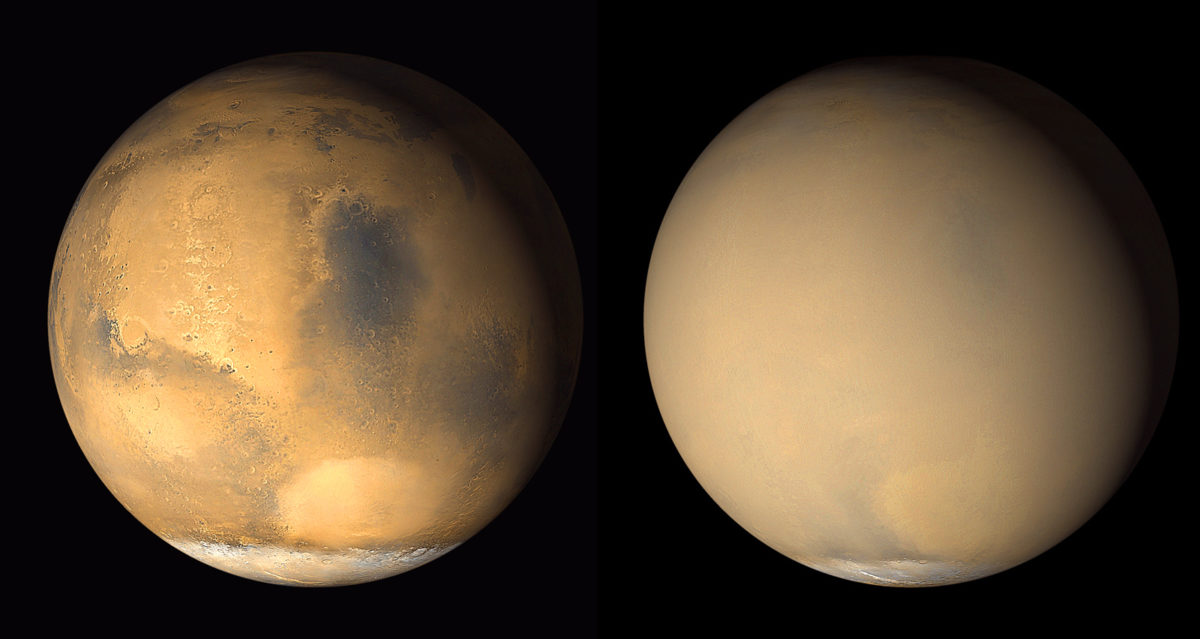
Being a robot, Opportunity has a real chance. If she can survive the cold without depleting her batteries, the MER ops team is cautiously confident that the robot will emerge and rove on from this storm.“We’ve taken what actions we can to try and get Opportunity through this,” said Nelson, “and we continue to strategize on how to respond to the storm, and how to recover the rover.”
Hope continues to spring eternal among MER team members, optimism is the still the order of the sol, and the mantra of gratitude is deeply ingrained: Every day on Mars is a gift. It’s a multidisciplinary perspective that has served the mission well.
That is not to say that there haven’t been some “somber” moments of late at the MER mission control at JPL, as Rover Planner Paolo Bellutta described them. “The Tau [atmospheric dust measurement] is so high that it is basically the difference between a full sunshine day and a full moon night kind of state.”
The lack of sunshine can be a downer for anyone and especially for any solar-powered ‘bot. Beyond the determination, devotion, skill, and optimistic attitude of the MER team however, there are scientific reasons and some Martian realities that justify the team’s hopeful outlook, even now at this, seemingly, darkest hour.
For starters, despite the extreme, dusty drama in which Oppy is currently starring, there is actually some good news.Yes, it’s true. While the powdery Martian dust is certainly not a rover’s friend, the thing about these dust storms is that they can actually limit the extreme temperature swings the robot experiences on the Martian surface.That’s because the same swirling dust that blocks sunlight also absorbs heat.
As the mission’s luck would have it, this ‘dirty’ little phenomenon seems to have efficiently raised the ambient temperature around Opportunity. “Right now there’s so much dust in the atmosphere and being the spring season, it seems to be warm at the surface,” said Arvidson. “Temperatures are flattening out,” confirmed Nelson. Better still, the rover is heading toward summer, not winter like Spirit was when she was trying to free herself at Troy.

What that means is Opportunity won’t have to immediately tap into her precious battery power just to keep warm. More specifically, to keep her body and her Rover Electronics Module (REM) warm, where her “brain” and other life essential instruments are ensconced. And that buys the MER team and their robot time to survive.
“We think that the warm surface temperatures and the fact that the rover doesn’t have to start heating the REM for some number of sols might be our saving grace,” Arvidson said, recounting a recent email discussion with Squyres.
Another point worth reiterating is that this isn't Opportunity's first dusty rodeo. Back in June-July 2007, when the planet-encircling storm enveloped the Red Planet, the rover spent two weeks saving power and doing very minimal tasks, enduring several days out of contact with the team to save power. Ultimately, the 2007 storm subsided in a matter of weeks and Opportunity dusted herself off and carried on.
“From the rovers' perspective, the big difference is that the '07 storm started slowly, and we saw dust drifting in from distant regional storms, and this time around, it seemed to be a direct hit from the regional storm that seems to be kicking off the activity,” said Lemmon.
Only time will tell where this storm goes or if experience plays a role in this rover’s survival. For now, the team is committed and staying strong as it stands by Opportunity.
“It remains to be seen,” said Arvidson. “But I wouldn’t bet against this rover.”
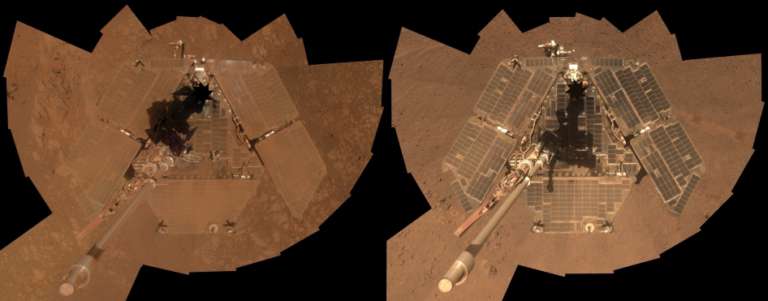
Huge dust storms like the one blowing around Mars right now are not surprising, but they are infrequent enough to be called rare. They can whip up suddenly like this current storm did, build for weeks, and become planet encircling events that last a long time, or not.
One thing Opportunity and this storm have made clear is that there is a lot more we need to learn about Martian dust storms.
What Mars scientists do know is that during summer in the planet’s southern hemisphere, sunlight warms dust particles, lifting them higher into the atmosphere, which creates more wind. That wind kicks up yet more dust creating a feedback loop that NASA scientists are still working to understand.
In its fury, the current storm threatening Opportunity presents “an unprecedented opportunity to learn more about Mars, and the many challenges that it presents for exploration,” as Jim Watzin, Director of the Mars Exploration Program at NASA Headquarters, defined it during the teleconference.
The space agency is all in. NASA has enlisted every one of its assets at Mars – the Odyssey, MRO, and Maven orbiters, and, on the surface, Curiosity, and whenever possible Opportunity – to enable scientists to observe and study this massive storm from many different perspectives with cameras and other science instruments.
One of the obvious objectives of this research is to be able to better forecast the dust storms on Mars, especially these powerful planet-encircling storms. “Knowing and understanding how these storms behave will be critically important for our ambitious missions being prepared for the future, such as Mars Sample Return, which is envisioned to be solar-powered,” said Watzin.
And, while robot pioneers are currently blazing the first trails across Mars, future human missions loom large in the space exploration psyche these days. When those human crews eventually take off, “it will be important to monitor and predict these storms for the safety of the crew,” he added.
You may remember that a couple of Earth years ago, in 2016, JPL planetary scientist James Shirley predicted a global dust storm would appear that Mars year. “Mars will reach the midpoint of its current dust storm season on October 29th of this year,” he wrote. ”Based on the historical pattern we found, we believe it is very likely that a global dust storm will begin within a few weeks or months of this date.” He was close, only one Mars year off.
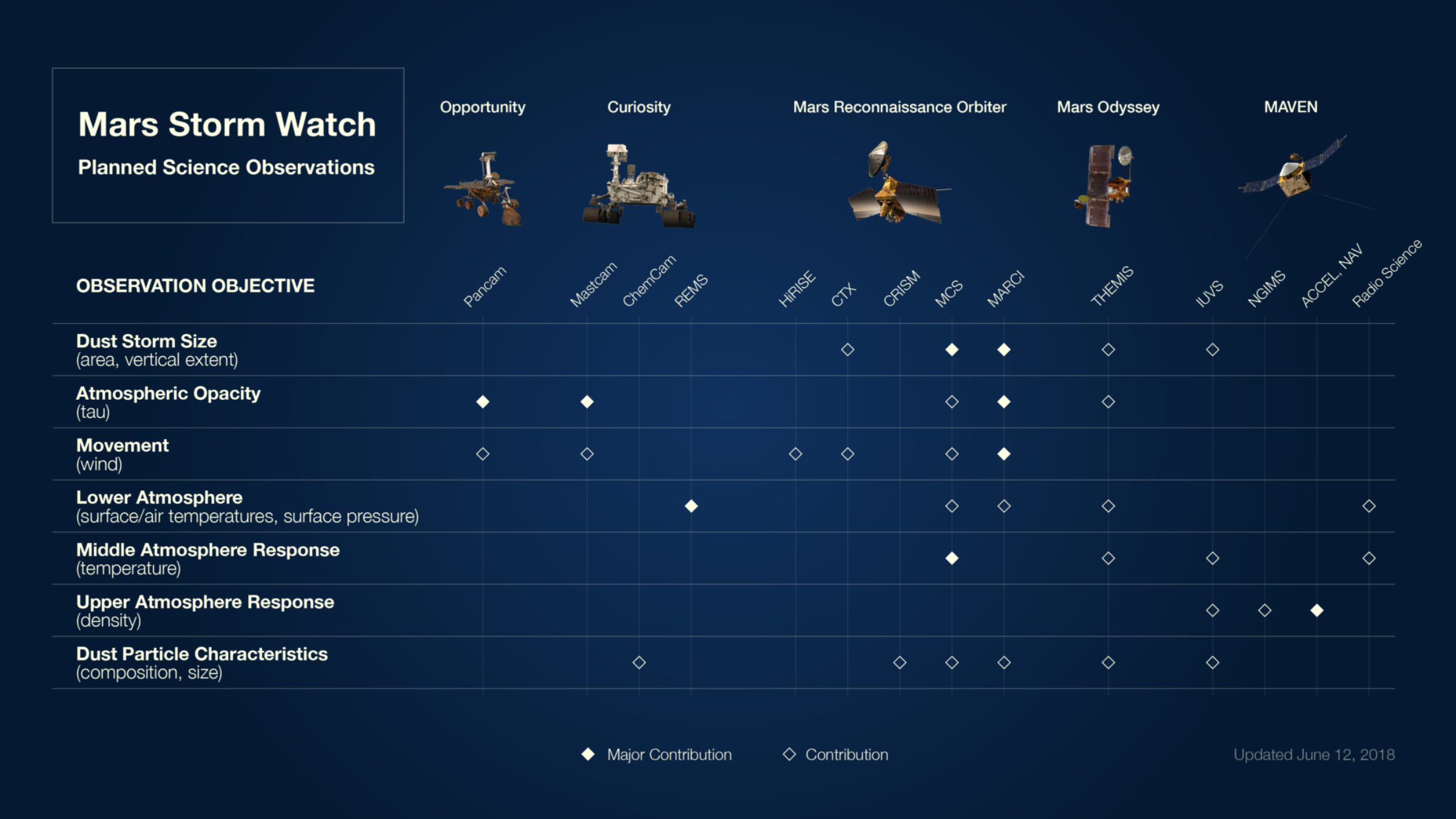
For whatever still-unknown reasons, the planet-encircling storm that didn’t happen during the last Mars year is happening now. Moving forward, the goal ostensibly is to take Mars Storm research beyond historical patterns and deeper into the hows and whys, the specificities of dust storm formation. What makes a storm go big and what causes others to dissipate within a few sols? Do huge storms always last for months or not? How long does it take for the dust lifted up into the atmosphere to come down? What storms can be predicted and are there those that cannot be foreseen?
The only way to learn the answers is to observe and study the storms from orbit and up close on the ground. “Each observation brings us closer to being able to being able to model these dust storm events and perhaps one day even being able to forecast them, like we forecast El Niño on Earth or hurricanes on Earth,” said Zurek.
Despite being in the thick of it and hunkered down, Opportunity has already contributed unique data. “Opacity above 10 is not unusual, theoretically, inside the big, active areas of global events,” said Lemmon. “We've just never seen it from the inside until now.”
That is something that drove home another point. It may seem easy to make a determination about something from orbit, but Opportunity has shown that features viewed and defined from above can turn out to be quite different when studied up close on the surface. “Ground-truth is a good thing,” Zurek summed it up simply.
The attention and the danger of this storm have brought NASA’s support for Opportunity front and center. The MER team has requested and has already been given additional communications coverage from the DSN to communicate with their ‘bot.
At this point though, the team is in “a waiting mode,” Callas said. “We’re hopeful that the storm will clear and the rover will begin to communicate with us.”
For her part, Opportunity was healthy and performing well before this storm darkened her doorstep. Her rechargeable lithium ion batteries are diehard dependable. After 5000 charges and discharges, they are estimated to have 85% capacity left, informed Callas.
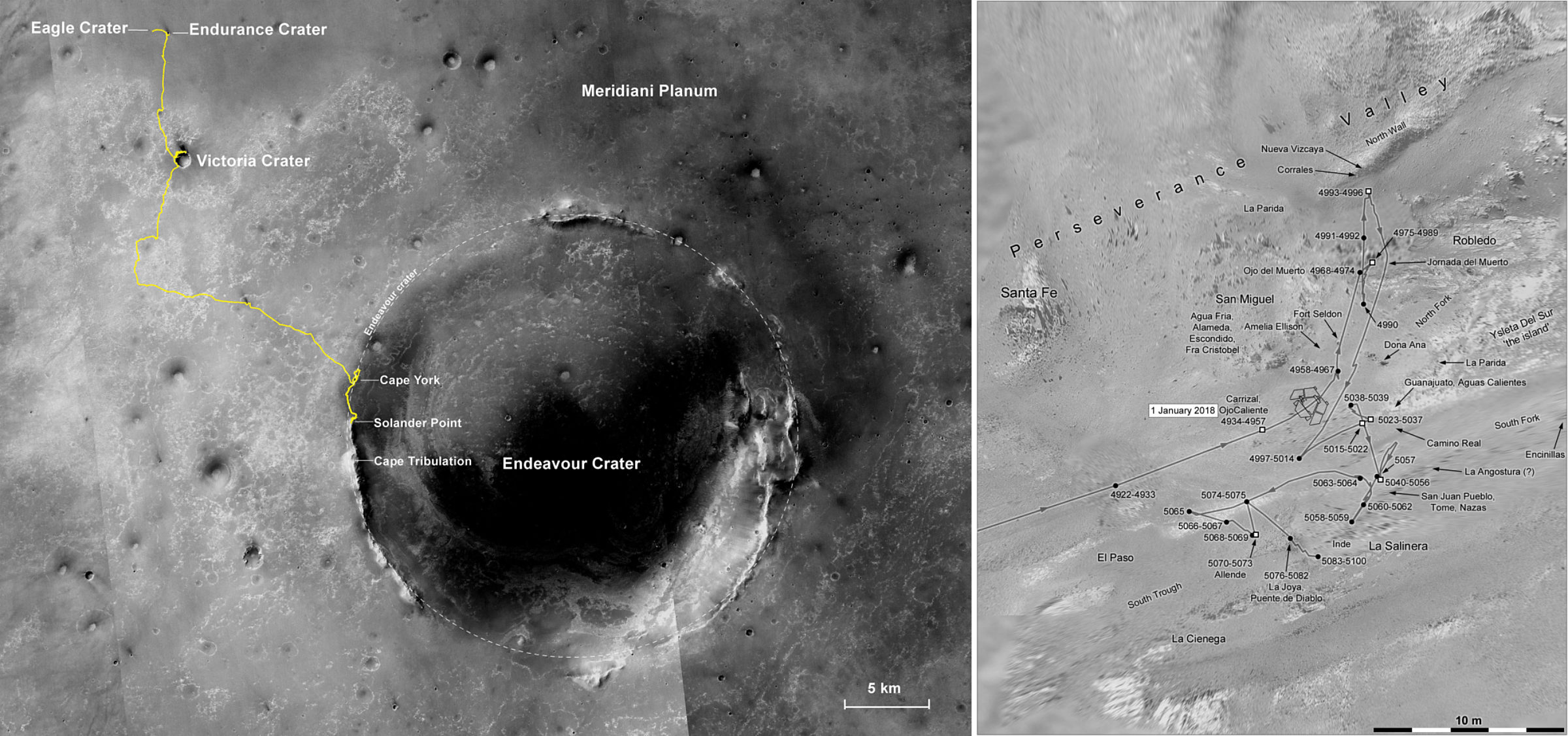
Moreover, a thermal simulation projection the MER ops team recently conducted provided more good news on that front that is bolstering the team’s inherent optimism. “We have a detailed thermal model of the rover set in the environment if we use the last recorded info from Mars and we’ve run that model out for many, many days,” said Callas. “What we find is that the rover hits a steady state temperature where there’s a balance between what little energy is coming out of the rover and being lost to the environment.”
In a couple of days, Opportunity “should hit that steady state point,” he said. “Then, we should be able to sit where we are for an extended period of time, until either the skies clear and we get power, or if the storm persists, its expected that these temperatures would persist around the vehicle.”
The thermal modeling indicates then that Opportunity should stay above her minimum allowable operating temperatures over the long term and not suffer the life-threatening cold of Mars. Designed to go to -55 Celsius, the allowable flight temperature (AFT) for the MER model rover is -40 degrees Celsius,” said Callas.Opportunity’s last data transmission received June 10th showed her temperature to be about minus 29 degrees Celsius (minus 20 degrees Fahrenheit), so the rover is in good shape in terms of temperature.
And, another tiny buffer is provided by the8 plutonium RHUs onboard. These radioisotope heater units provide heat through radioactive decay inside the rover’s body, known as the Warm Electronics Box (WEB), which protects the rover´s computer, electronics, and batteries or the equivalent of the rover´s brains and heart.
“These each generate about 1 watt,” said Callas. “So even though we’re not getting any solar energy on the rover there is still about 8 watts of thermal energy inside the insulated box of the rover.”
“Opportunity is in a relatively benign thermal environment – and this dust storm won’t last forever,” said Nelson.“Given that the thermal simulations indicate Oppy will actually stay above AFT even with a dead battery, this gives great hope that the rover can be recovered once the dust storm dissipates.”Added Callas: “We should be able to ride out this storm.”
If Opportunity is in a low-power fault mode, as it surely must be by now, then she is currently operating in a kind of auto mode. “The vehicle knows what to do and as long as it can maintain some degree of power and heat the interior, then we’re okay,” said Arvidson. If everything goes as designed and according to plan, when the sky is clear and the rover begins to power up, she should phone home.

If the clock – what ops engineers call the sclock (for spacecraft clock) – has been turned off (as was expected for Spirit back in 2010), that means Opportunity won’t know what time it is once she does recharge and wake up. And that means, the ‘bot won’t know when her communications windows are. However, the robot is intelligent enough to recognize when the Sun is out, Callas assured, and will to try to communicate only during daylight hours.
Of course the uncertainty in clock time would make for a more involved recovery process. The ops engineers would have to “chase” the communication windows, as MER Mission Manager Scott Lever put it. In other words, the engineers would have to make calculated guesses as to what time Opportunity would be trying to phone home, and be ever-watchful and vigilant until they connected with their ’bot. “But it’s do-able. We can reset the sclock and get the rover back on track,” Lever said.
Right now, it looks like it’s up to Mars. The really big worry is whether this storm will rage on for months. Although it has to be in the back of everyone’s mind, no one’s really going there right now.“Steve [Squyres] and Ray [Arvidson] always say never bet against the rover – and the one time I did years ago, I had to go to Italy and buy a bottle of Chianti for Steve – so I keep being optimistic,” explained Bellutta.
In the midst of another long day after 14 years and some six months of roving Mars, Squyres paused to reflect on the mission’s latest dilemma. True to character he made no predictions. “Mars exploration is never easy, and this storm is a vivid reminder of why,” he said. “We'll see what we see.”
For more and the latest news, check back for the regular issue of The Mars Exploration Rovers Update, which will post, as usual, just after June gives way to July.

The Time is Now.
As a Planetary Defender, you’re part of our mission to decrease the risk of Earth being hit by an asteroid or comet.
Donate Today

 Explore Worlds
Explore Worlds Find Life
Find Life Defend Earth
Defend Earth

